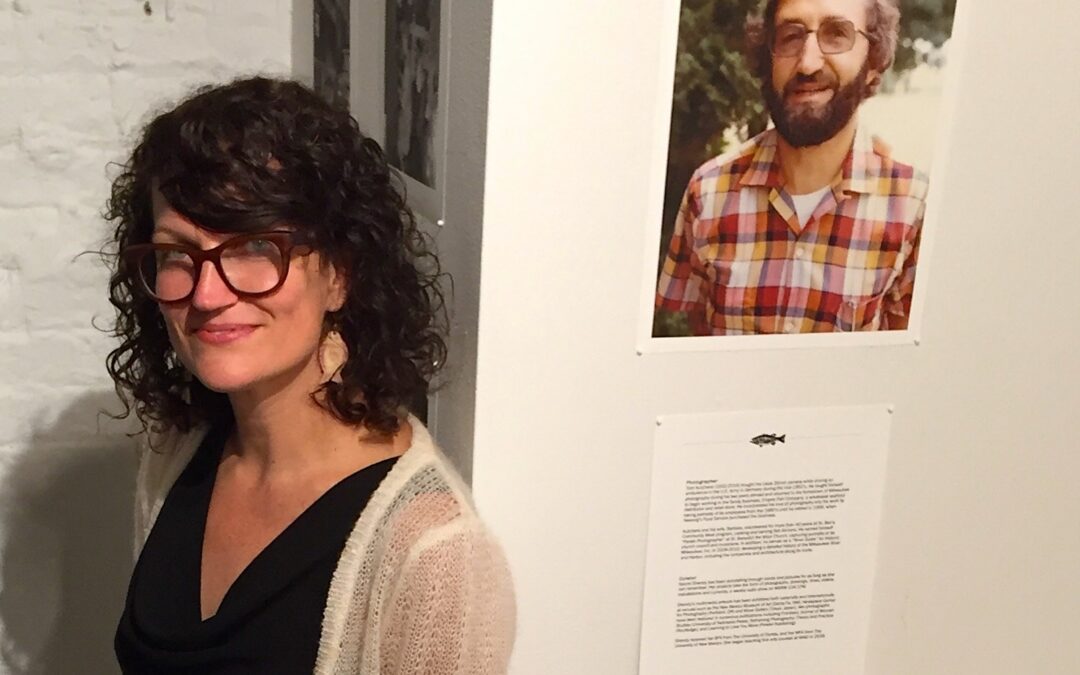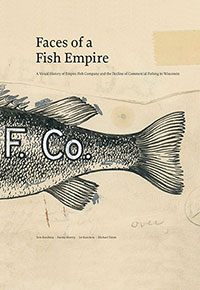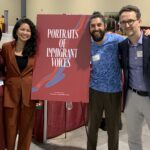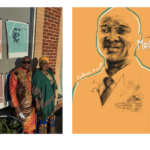Seven years ago, Naomi Shersty organized a photo exhibit of my Dad’s portraits of Empire Fish Company employees, which opened on Labor Day Weekend. This week, the Wauwatosa Public Library welcomes our updated and expanded exhibit to its gallery space with new photos, oral histories, and research about commercial fishing on Lake Michigan, again opening on Labor Day Weekend.
The setting for this show is especially exciting since my Dad loved the Wauwatosa Public Library. He held a life-long interest in literature and found inspiration in Andrew Carnegie’s quote: “There is not such a cradle of democracy upon the earth as the Free Public Library…where neither rank, office, nor wealth receives the slightest consideration.” He served on the Wauwatosa Library Board from 1979–94 and as its president from 1980 –87. Concurrently, he served on the Milwaukee County Federated Library System (MCFLS) board from 1979–95 and as its president twice from 1984–86 and again in 1993–95.
I first met Naomi at my Dad’s funeral in April 2016. She loved his collection of employee portraits and spent that summer scanning, color correcting and printing new digital versions of his photos, pitching the show idea to Debra Brehmer at Portrait Society Gallery. It blew my mind to think that someone who never even met him could invest so much time and energy in recreating his photos into a gallery exhibit, like an angel coming out of thin air. You can read her forward to our book below, which describes her experience of working on this project.
My Dad’s portraits were never intended to be a photo exhibit. The photo albums were a collection of portraits of “a work family,” as Naomi described it, of the employees at Empire Fish Company. My Dad occasionally took his camera to work to take a few portraits of the employees every week, capturing people impromptu, working on the job, perhaps shortly after telling them a joke or even surprising them with his camera. Photography served as a creative outlet for him but also as a way to connect with employees through something that he enjoyed. During that era of film cameras (before digital photography), he gradually brought the rolls of film to Mike Crivello’s Camera store to be developed. He then posted the best portraits on a pin board, near the employee entrance. Over time, he aggregated the portraits into two photo albums and stored them that way…until Naomi found them.
When Portrait Society Gallery first hosted the exhibit, our journey started as an homage to our Dad. Then, after that exhibit, my brother, Andrew Kutchera, designed our book, using all of Naomi’s scanned images. I wrote the text, collaborating with Michael Timm, who helped me add research about Wisconsin’s fishing industry. The book evolved into honoring not only Empire Fish but also Wisconsin’s family-owned fish companies, which I distinctly remember my grandfather, Harold, telling me about around the dinner table. He fondly recalled working and socializing with the other members of the Wisconsin Fish dealers Association, a community of family-owned fish companies that has long since disappeared.
I once brought up my work on this project during a conversation in my Meditative Inquiry Meditation group at the Ekoji Buddhist Sangha, with whom I’ve practiced meditation for many years. We discussed paying attention to and becoming aware of all of the workers that make our meals possible – truck drivers, fish cutters, berry pickers, and retail workers – many of whom work behind the scenes. With that perspective, it felt humbling to realize just how many people bring the ingredients for our meals in today’s modern food supply chains. (Ever since the pandemic started, my meditation group convenes virtually every Wednesday via Zoom.)
Since then, I’ve presented our project a number of times over the years. It remains an homage to my Dad and the former employees at Empire Fish Company but has also evolved to become a meditation on food workers everywhere, for whatever we eat. And bringing the exhibit to the public at the Wauwatosa Public Library serves as a kind of homecoming for my Dad, remembering his volunteer work there, but also for me since I graduated from Wauwatosa East High School just down the street. I also share the exhibit in the hopes that it will inspire other organizations and companies to capture their employees in fun and memorable ways, just as my Dad did with his co-workers.
Many thanks to the Wauwatosa Public Library for hosting the exhibit and to Naomi Shersty for starting this whole project. Thank you to everyone who hosted the exhibit or invited me to present the book over the last seven years, especially Portrait Society Gallery, Wisconsin Marine Historical Society, Tamarkin Camera/Rangefinder Gallery, Wauwatosa Historical Society, the Racine Lighthouse and Preservation Society, and Neville Public Museum.
Labor through a Fresh Lens: Portraits by Tom Kutchera
By Naomi Shersty
It is difficult to explain the impact that Tom Kutchera’s photographs have had on me. So first, a backstory: On April 29th, 2016, I accompanied my friend Xav Leplae to Tom Kutchera’s memorial—Xav is a long-time friend of Tom’s son, Joe. Among the flowers and warm faces, my eye lighted on the photo boards, a familiar sight at memorials. The scrapbook-esque displays drew me in, due in part to my lifelong fascination with the narrative potential of photography. The photo boards, categorized by family, work, and travel captured my attention briefly.
Then I noticed two photo albums atop a table against the far wall. I recognized a floral pattern cover (circa the 1960s) that immediately reminded me of my own family’s photo albums, ones that I have pored over time and time again. Family photo albums are unique in that they possess both facts and fictions, inclusions and exclusions, as well as a focused care that is given to arranging singular snapshots into a larger narrative. I rushed over to peruse them. To my surprise, these albums held photographs of a different kind of family: a work family, Empire Fish Company laborers who spent the majority of their waking hours together working toward a common goal, supplying fish to their local community.
Yet, these were no ordinary photographs of workers going about their day. Each portrait revealed an unexpected intimacy, an attention to photographic composition, and a seemingly comfortable bond between the subject and the photographer. I was hooked and had to know: What is the story behind these photographs? Who are these people? After suppressing my excitement enough to make a tactful inquiry, I learned that they were photographs Tom Kutchera took of his employees.
As I studied the images, I could hardly believe that a “boss” had taken these photographs. There is a leveling of the playing field within these frames—eyes even with the camera. There is an intimate proximity between the subject and photographer—sternum to head filling the frame. The photographer exerts no obvious power; it is almost as if each subject is caught in dialogue with a friend or family member—not a superior. These are elevated images of laborers: well-composed, properly exposed, and shot on film. Tender, warm, nostalgic, at times fun, these photographs embody what draws me to portraiture. They are ripe with narrative potential. These extraordinary portraits mesmerize me.
One does not often find, within the genre of workplace photography, class and power broken down in this way. And so, as I continue to look through these unique portraits, I am captured. I am smitten. I do not want to stop looking at them.
I thought others might feel the same. Since approaching Tom Kutchera’s son at the memorial to ask about exhibiting the photographs would have been a little uncouth, I waited until the next morning, and asked at the post-memorial brunch. Happily, Joe was excited about the idea. After a series of meetings, first in Tom and his wife Barbara Kutchera’s basement, and later at Portrait Society Gallery, the first exhibition came into being–less than three months after the memorial!
Lucky me—I got to live with the original photographs for the summer. I scanned and printed 80–100 of Tom Kutchera’s images with the help of our dedicated assistant, Aideen Brown. We had an exuberant opening, arranged by Joe and his family and catered by Empire Fish Company. That night, we celebrated not only the photographs and Tom Kutchera’s talent and warmth, but also the former Empire Fish employees, the working class of Milwaukee, and the history of the fishing industry here in Wisconsin. Tom Kutchera’s photographs encourage viewers to reflect on this past, and also to consider present and future food production, distribution, and working-class relations.
Although I did not get a chance to meet Tom Kutchera, I get a strong sense of his humanity through his eye as a photographer. What a special experience and a unique project of which to be a part. I am grateful for his keen eye, his tender treatment of his subjects, and his unexpected collection of photographs. It is an honor to have shared his photographs with the Milwaukee public, which is comprised of a long history of working-class folks who deserve to be remembered.








